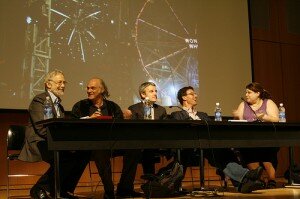Coney Island Panel Recap
Last Thursday’s panel discussion at CUNY was fascinating – and contained some critical perspectives on the future of Coney  Island. Here are some of the highlights.
Island. Here are some of the highlights.
Veteran developer David Malmuth argued that the key to Coney Island’s long-term success is gaining control of critical parcels of land in the amusement area through an acquisition of land by a public or civic entity. These include parcels currently owned by Thor Equities and Horace Bullard.
Malmuth cited the enormous success of Luna Park, which was made possible by a purchase of land last December by the City. But he argued that more land needed to be purchased to make the amusement area a true destination and to safeguard the future of the historic buildings threatened with demolition.
Citing research he did for the Municipal Art Society’s “Imagine Coney” project, he said that “Coney could easily draw 3.5 million people” a year, but that at least 26.5 acres of land for rides were require to accommodate this level of attendance. At present, he said, only 11.5 acres of land are set aside for amusements and only 6.5 acres are in active use currently.
“Size does matter,” Malmuth said. “If we’re going to make Coney Island a successful destination, we have to get to a certain scale that allows it to be able to draw people, and hopefully draw people on a year-round basis.”
But he warned that because of recent real estate speculation, land prices in Coney Island’s amusement district are currently too expensive for operators to be able to invest in buying land for amusements.
“There’s a real mismatch between the private ownership of the land and public interest,” Malmuth said. “Either the city or some civic-minded entity needs to step up and carry the major load in acquiring property, so that all of the things that we want to have happen can be enabled” Malmuth said.
Malmuth pointed to the role that government played in revitalizing Times Square and 42nd Street. He noted that public investment and land acquisition played a pivotal role in the redevelopment of Times Square and turning it into a key economic engine for New York, “generating billions of dollars annually.”
Malmuth also suggested that a civic or public purchase of Coney Island’s historic buildings, several of which are now threatened with demolition by Thor Equities, was also necessary to revitalize the amusement area.
“Keeping those historic buildings is massively important in terms of connecting people to place. If you knock them down, then it could be anywhere along the water’s edge,” Malmuth said. “Buat if you keep those buildings, and you transform them, it’s a statement of hope that is really extraordinarily powerful”.
Zamperla USA CEO Valerio Ferrari’s presentation focused on how Zamperla got involved in Coney, how they put Luna Park together in 100 days, and what their plans for the new Scream Zone are. The Scream Zone will be built on two land parcels on either side of Stillwell Avenue adjacent to the boardwalk and will contain new rides like a Slingshot, Turbo Force, American Eagle Roller Coaster and a Steeplechase Cavalry Coaster. Ferrari also discussed aspects of Coney Island he like to see improved — like the furniture stores on Surf Avenue, which he’d like to see replaced by uses that enhance the amusement area, and the lack of sit-down dining options for families visiting Coney Island.
Historian Michael Immerso gave a historical overview of Coney Island and World Monuments FundChief Operating Officer Lisa Ackerman put Coney Island in the context of other extraordinary American landscapes, including the 1964 World’s Fair Unisphere in Flushing Meadows Park and Route 66. Ackerman discussed how important the preservation of Coney Island’s landscape is from an international perspective.
With regards to Malmuth’s presentation, we agree that more land needs to be acquired — both for amusements and to safeguard the threatened historic buildings. Unfortunately, the City at this moment seems unlikely to make this kind of investment. Other sources of funding — such as a land trust, philanthropic or civic entities, or even sources at the federal level — need to be identified. We’ll be studying this issue over the next few weeks.